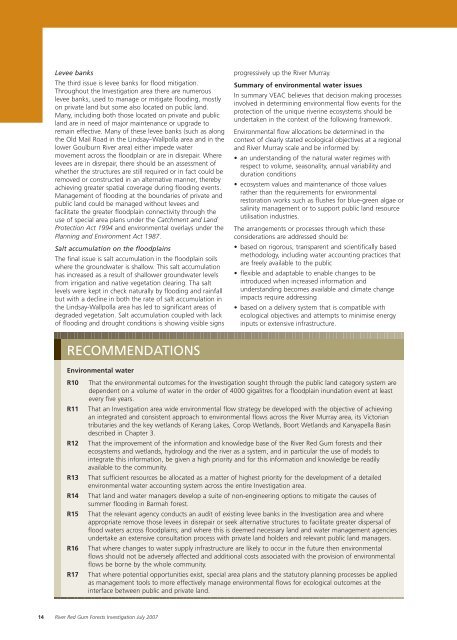Draft Proposals Paper - Full - Victorian Environmental Assessment ...
Draft Proposals Paper - Full - Victorian Environmental Assessment ...
Draft Proposals Paper - Full - Victorian Environmental Assessment ...
Create successful ePaper yourself
Turn your PDF publications into a flip-book with our unique Google optimized e-Paper software.
Levee banks<br />
The third issue is levee banks for flood mitigation.<br />
Throughout the Investigation area there are numerous<br />
levee banks, used to manage or mitigate flooding, mostly<br />
on private land but some also located on public land.<br />
Many, including both those located on private and public<br />
land are in need of major maintenance or upgrade to<br />
remain effective. Many of these levee banks (such as along<br />
the Old Mail Road in the Lindsay–Wallpolla area and in the<br />
lower Goulburn River area) either impede water<br />
movement across the floodplain or are in disrepair. Where<br />
levees are in disrepair, there should be an assessment of<br />
whether the structures are still required or in fact could be<br />
removed or constructed in an alternative manner, thereby<br />
achieving greater spatial coverage during flooding events.<br />
Management of flooding at the boundaries of private and<br />
public land could be managed without levees and<br />
facilitate the greater floodplain connectivity through the<br />
use of special area plans under the Catchment and Land<br />
Protection Act 1994 and environmental overlays under the<br />
Planning and Environment Act 1987.<br />
Salt accumulation on the floodplains<br />
The final issue is salt accumulation in the floodplain soils<br />
where the groundwater is shallow. This salt accumulation<br />
has increased as a result of shallower groundwater levels<br />
from irrigation and native vegetation clearing. Tha salt<br />
levels were kept in check naturally by flooding and rainfall<br />
but with a decline in both the rate of salt accumulation in<br />
the Lindsay-Wallpolla area has led to significant areas of<br />
degraded vegetation. Salt accumulation coupled with lack<br />
of flooding and drought conditions is showing visible signs<br />
progressively up the River Murray.<br />
Summary of environmental water issues<br />
In summary VEAC believes that decision making processes<br />
involved in determining environmental flow events for the<br />
protection of the unique riverine ecosystems should be<br />
undertaken in the context of the following framework.<br />
<strong>Environmental</strong> flow allocations be determined in the<br />
context of clearly stated ecological objectives at a regional<br />
and River Murray scale and be informed by:<br />
• an understanding of the natural water regimes with<br />
respect to volume, seasonality, annual variability and<br />
duration conditions<br />
• ecosystem values and maintenance of those values<br />
rather than the requirements for environmental<br />
restoration works such as flushes for blue-green algae or<br />
salinity management or to support public land resource<br />
utilisation industries.<br />
The arrangements or processes through which these<br />
considerations are addressed should be:<br />
• based on rigorous, transparent and scientifically based<br />
methodology, including water accounting practices that<br />
are freely available to the public<br />
• flexible and adaptable to enable changes to be<br />
introduced when increased information and<br />
understanding becomes available and climate change<br />
impacts require addressing<br />
• based on a delivery system that is compatible with<br />
ecological objectives and attempts to minimise energy<br />
inputs or extensive infrastructure.<br />
RECOMMENDATIONS<br />
<strong>Environmental</strong> water<br />
R10<br />
R11<br />
R12<br />
R13<br />
R14<br />
R15<br />
R16<br />
R17<br />
That the environmental outcomes for the Investigation sought through the public land category system are<br />
dependent on a volume of water in the order of 4000 gigalitres for a floodplain inundation event at least<br />
every five years.<br />
That an Investigation area wide environmental flow strategy be developed with the objective of achieving<br />
an integrated and consistent approach to environmental flows across the River Murray area, its <strong>Victorian</strong><br />
tributaries and the key wetlands of Kerang Lakes, Corop Wetlands, Boort Wetlands and Kanyapella Basin<br />
described in Chapter 3.<br />
That the improvement of the information and knowledge base of the River Red Gum forests and their<br />
ecosystems and wetlands, hydrology and the river as a system, and in particular the use of models to<br />
integrate this information, be given a high priority and for this information and knowledge be readily<br />
available to the community.<br />
That sufficient resources be allocated as a matter of highest priority for the development of a detailed<br />
environmental water accounting system across the entire Investigation area.<br />
That land and water managers develop a suite of non-engineering options to mitigate the causes of<br />
summer flooding in Barmah forest.<br />
That the relevant agency conducts an audit of existing levee banks in the Investigation area and where<br />
appropriate remove those levees in disrepair or seek alternative structures to facilitate greater dispersal of<br />
flood waters across floodplains; and where this is deemed necessary land and water management agencies<br />
undertake an extensive consultation process with private land holders and relevant public land managers.<br />
That where changes to water supply infrastructure are likely to occur in the future then environmental<br />
flows should not be adversely affected and additional costs associated with the provision of environmental<br />
flows be borne by the whole community.<br />
That where potential opportunities exist, special area plans and the statutory planning processes be applied<br />
as management tools to more effectively manage environmental flows for ecological outcomes at the<br />
interface between public and private land.<br />
14 River Red Gum Forests Investigation July 2007
















